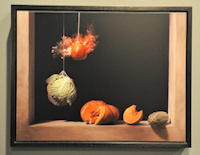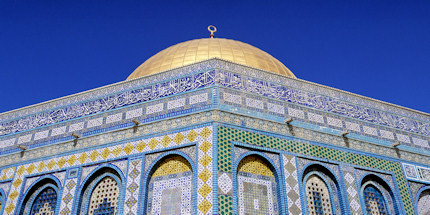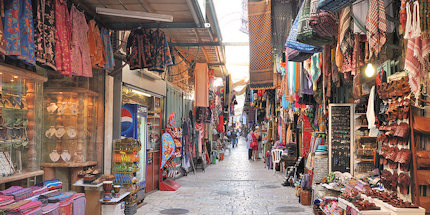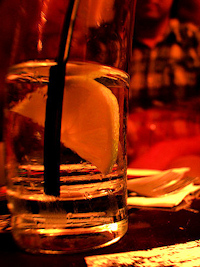Israel's tale of two cities: Tel Aviv vs Jerusalem
Jerusalem’s got the monuments, whilst Tel Aviv has the nightlife – that’s what the brochures say. But it’s definitely not the whole story. Whether you want culture, shopping or nightlife, both cities have plenty to offer. Ruth Styles uncovers the secret spots that will clear your preconceptions.
Getting arty
 See works of Ori Gersht
See works of Ori GershtCreative Commons / Julian Stallabras
Tel Aviv, at barely 100 years old is a young city, blessed with a golden sand seafront, perfectly preserved Bauhaus architecture and a thriving art scene. Much of it centres on the old port of Jaffa. There, along with a busy artists’ quarter, you’ll find Maskit, Israel’s only couture house, now owned by a designer who, in a previous life, was head of embroidery at Alexander McQueen. For a more solid sight, head to Rothschild Boulevard, a 1950s gem lined with modernist buildings and dotted with cafes, in the city centre. For a taste of what the city’s young artists can do, head to Noga (60 Ehad Ha'am Street), where you’ll find work by up-and-coming talents such as Keren Cytter and Ori Gersht.
Meanwhile in Jerusalem, there’s the wonderful Jerusalem Artists’ House (12, Shmuel Hanagid Street) which offers a glimpse of contemporary Israeli art, as well as the fascinating Vision Gallery (12 Yosef Rivlin Street) which is dedicated to modern photography.
A glimpse of the past
With the Dome of the Rock, the Mount of Olives and the Wailing Wall all within its city limits, it’s safe to say that Jerusalem isn’t short of historical sites. In the Israeli capital, the past, to use a hackneyed cliché, is quite literally everywhere you look. Start with a trip to the Old City, beginning at the Wailing Wall. The last remnant of the Jewish temple destroyed by the Romans, the monument presses up against the Dome of the Rock and overlooks a square constantly thronged with tourists and religious pilgrims. On the other side, near the Jaffa Gate, is the imposing Tower of David which is part of a citadel complex that dates from 2BC. For a taste of the more recent past, head to Yad Vashem (Har Hazikaron), a hulking modernist building that houses a haunting series of exhibitions documenting the Holocaust.
 Jerusalem is home to the dome
Jerusalem is home to the domeBrand X Pictures
Back in Tel Aviv, city centre monuments are few and far between, so hop on a bike for the short journey to the ancient port of Jaffa. Overlooking the deadly rocks of Andromeda, the port was once at the end of the silk route and has been occupied by a succession of invading armies, including the Romans, Crusaders, Ottomans and latterly, British. The streets of the old town are a rabbit warren of quirky boutiques selling art and jewellery, and you’ll also find the skeletal remains of the city’s last orange tree.
Tucking in
Rocks named after goddesses and quaint art shops might dominate Jaffa’s press, but it’s also famous for its oranges, who, among other things, gave their name to the Jaffa cake. But oranges aren’t the only culinary treat the ancient port has to offer. It’s also famous for being home to the best shawarma [Middle Eastern kebabs] in Israel. At Dr Shakshuka (3 Beit Haeshel Street), it’s served in a covered courtyard, is cooked to order and comes with just about every topping imaginable, including some excellent tahini paste. Also on the menu is shakshuka, a lighter dish of baked tomatoes and eggs.
In Jerusalem, foodies focus on local, fresh produce and as a result, the capital has plenty of interesting places to lunch. Best of all is the bustling Machne Yehuda market, a short walk from central Jerusalem, where you can spend a morning filling up on little bits of halva, salty goat’s cheese and tangy freshly squeezed lemon juice. For 99 shekels (about £18), the market offers a highly useful Shuk Bites card, which allows a free tasting at six participating stalls; don’t miss delicious Georgian salty cheese pies and sour Kubbeh soup.
Souvenir hunting
After lunch, head further into the city for a little retail therapy. Along with the inevitable tacky tourist outlets, central Jerusalem is home to the Mamilla Mall, a small, sunken street of open-air boutiques that was built on top of what was the green line between Israeli and Jordanian Jerusalem. While the majority of the shops house Western brands such as Zara and Topshop, the mall is also home to the Mamilla Hotel, which has spectacular views of the Old City from its roof terrace. The Old City itself is home to a sprawling bazaar, much of which is concentrated in the Arab and Christian quarters. Expect plenty of religion-themed souvenirs, along with (better value) pomegranate juice hawkers.
 Shop around the bazaar in Jerusalem
Shop around the bazaar in JerusalemCreative Commons / Jorge Lascar
By contrast, Tel Aviv doesn’t do bazaars. Instead, it does neat boutiques (the Neve Tzedek neighbourhood is best if you’re in the market for luxury labels) and quirky markets, among them the excellent Nahalat Benyamin craft fair which takes place on Tuesdays and Fridays. Here you’ll find everything from handmade Dead Sea mud soap to wonderful handmade jewellery. It’s also close to the busy Carmel food market should you fancy a snack, or a pair of underpants emblazoned with the Star of David.
After dark
 Try a cocktail featuring a Jaffa orange
Try a cocktail featuring a Jaffa orangeCreative Commons / WBNworkshop
The night scene thrives in Jerusalem as well, which along with the inevitable Irish bar (Dublin on Shammai Street) also boasts clubs that manage to be busy even on Tuesday nights. Pick of the bunch is HaTza'atzua (6, Dhu Nuwas Street), which does excellent cocktails and stays open until 3am. It’s not for everyone though, so for a more sedate evening, try the nightly light show at King David’s Citadel. It’s a spectacular way to end a day in the Israeli capital.
Do you have any Feedback about this page?
© 2026 Columbus Travel Media Ltd. All rights reserved. No part of this site may be reproduced without our written permission, click here for information on Columbus Content Solutions.









 You know where
You know where